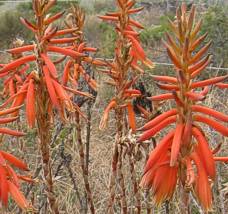Aloe brevifolia var brevifolia
Aloe brevifolia Mill. var. brevifolia
Family: Asphodelaceae
Common names: short-leaved aloe (Eng.); kleinaalwyn (Afr.)
Introduction
Aloe brevifolia is a stemless perennial succulent endemic to South Africa. It is a charming species and may be found in flower during the month of November.

Description
Description
Aloe brevifolia var. brevifolia plants usually form large groups of densely leafy rosettes. Leaves are broadly triangular and greyish green in colour. The upper surface is usually without any spots or spines but the lower surface may have a few soft spines along the upper middle or scattered on the terminal part. It has white thorns on the edge of the leaves.

One or two unbranched inflorescences are formed. Large bracts are present along the peduncle, which extend almost to the base. The racemes are cone-shaped and rather sparse lower down, but with the buds densely packed and hidden by the bracts. The flowers are various shades of red or sometimes yellow, tubular in shape but slightly curved, with the stamens protruding slightly from the mouth of the tube.

Aloe brevifolia may be distinguished from other dwarf aloes by the combination of the clustered growth form and the relatively broad and thick leaves.
Conservation Status
Status
Previously Aloe brevifolia was treated as not threatened. At present it is assessed as Vulnerable (VU), due to habitat loss because of agriculture, degradation by alien infestation and over-exploitation by plant collectors.
Distribution and habitat
Distribution description
The species is restricted to the Western Cape Province, and occurs naturally in the districts of Caledon and Bredasdorp, extending eastwards to Swellendam, Riversdale and Cape Agulhas. It is found in areas with a relatively high rainfall of about 400 mm per year and usually grows on clay soil in rocky places. It occurs from near sea level to about 150 m. Plants are sensitive to frost and cannot survive for long under Highveld winter conditions.

Derivation of name and historical aspects
History
The scientific name was well-chosen, brevifolia means short-leaved.
Aloe brevifolia belongs to the dwarf-aloe group; the flowers of all the species in this group are large in relation to the size of the plants and therefore very showy, which makes them highly sought-after collectors' items.
Based mainly on size and distribution differences, three varieties have been recognized. The largest of the three is var. depressa, from near Caledon, wich has rosettes of up to 300 mm, it is more spreading and the leaves are usually unspotted or sometimes tuberculate-spotted on both surfaces. The var. postgenita, from between Swellendam and Ashton, is intermediate in size and has longer leaves than the typical variety and its filaments are exserted. Aloe brevifolia var. brevifolia, the smallest.
Ecology
Ecology
Aloe brevifolia is mainly restricted to Rûens shale renosterveld, which has been classified as critically endangered according to the national spatial biodiversity assessment, as less than 20% of this vegetation type remains intact due to extensive transformation by agriculture. If fire is too hot and occurs in flowering time, the inflorescences will be burnt and no seed will be set. As a protective mechanism, Aloe brevifolia's fire survival strategy is to grow in rocky habitats that often escape the fire due to sparse vegetation cover.
Uses
Use
Aloe brevifolia is seen as an ornamental plant in dry gardens and is very attractive when flowering.
Growing Aloe brevifolia var brevifolia
Grow
Aloe brevifolia is commonly cultivated and thrives in well-drained soil. However it should be borne in mind that it prefers rain in winter and it cannot tolerate temperatures below -4°C. It needs full sun to partial shade with a well-drained soil mix. Plants respond to average watering, but they should be allowed to dry thoroughly before watering again as they are susceptible to damping off or rot near the base, therefore plenty of sand should be added, particularly near the surface.
Aloe brevifolia is propagated by removal of offsets or by seed which must be sown in warmer months.
References
- Bornman, H. & Hardy, D.S. 1971. Aloes of South African veld. Voortrekkerspers, Johannesburg.
- Court, D. 2000. Succulent flora of Southern Africa, revised edn. Balkema Publishers, Netherlands.
- Jeppe, B. 1969. South African aloes. Purnel, Cape Town.
- Smith, G.F. & Van Wyk, B. [A.E.]. 2008. Aloes in Southern Africa. Struik Publishers, Cape Town.
- Van Wyk, B.-E. & Smith, G. 2003. Guide to the aloes of South Africa, edn 2, first impression. Briza Publications, Pretoria.
Credits
Vathiswa Zikishe
Custodians of Rare & Endangered Wildflowers (CREW)
February 2010
Plant Attributes:
Plant Type: Succulent
SA Distribution: Western Cape
Soil type: Sandy, Clay, Loam
Flowering season: Early Summer
PH:
Flower colour: Red, Yellow
Aspect: Full Sun
Gardening skill: Average
Special Features:
Horticultural zones









Rate this article
Article well written and informative
Rate this plant
Is this an interesting plant?
Login to add your Comment
Back to topNot registered yet? Click here to register.